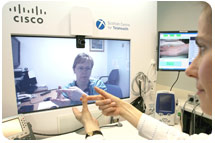 |
Emergency patients in North-East Scotland can now remotely consult with a doctor through video conferencing technology.
The deveopment comes as part of a new collaboration between Cisco and the Scottish Centre for Telehealth.
The new HealthPresence booth enables patients to remotely consult with a doctor, particularly useful should they live in a remote area, without close proximity to an A+E department.
Aberdeen Royal Infirmary hospital has been running the trial since December, with the aim of seeing 300 accident and emergency patients through video conferencing.
Sitting in front of a monitor with a webcam, patients are able to have a remote consultation with a doctor via the video-teleconferencing technology.
Patients can then use a range of medical devices, including blood pressure cuffs, glucose monitors, audioscopes and stethoscopes, which upload data directly into an electronic medical record. The patients using the booths are assisted by qualified first aid professionals to help them correctly use the devices.
Cisco Internet Business Solutions Group’s global healthcare solutions director, Nick Augustinos, told EHI: “The aim of these booths is to help patients in rural areas where treatment resources are scarce, to have somewhere to go, which is an environment very similar to what they see when they visit a GP, and is able to give them an accurate diagnosis without them having to go miles away.”
The Scottish Centre for Telehealth chose the Royal Aberdeen Infirmary’s accident and emergency department, as the 877 bed hospital serves the whole of North-East Scotland, including remote areas on the coastline.
Gordon Peterkin, director of the Scottish Centre for Telehealth, told EHI: “Scotland has already been an active player in the telehealth area and we wanted to extend this for the benefit of patients. We have had an idea of an interactive booth since 2006, where we displayed a hypothetical situation to Princess Anne at our conference, looking at providing the right treatment, for the right patient at the right time.
“What we have today, furthers our use of video conferencing, enabling us to provide a service to hundreds of patients seeking emergency treatment as well as having a resource for us to collect measurements from devices, transferred digitally by the system, which we can then in turn update into the Scottish Emergency Care Summary afterwards.”
The system has so far been used by 30 patients, and the hospital intends to see 300 patients before undertaking a £30,000 evaluation study to see if any modifications need to be made. Initial feedback from patients has been positive, and A&E staff are asking patients with different symptoms if they would like to participate to ensure an accurate trial group.
Treatment is performed both through video conferencing, and face-to-face to compare results as part of this evaluation.
Once the evaluation has been completed, the centre wants to provide an additional service at a safe remote site, probably community hospitals, available around the clock to patients living in remote parts of Scotland such as the Shetland islands.
Peterkin said a specialised reference group was working on detailing the feasibility of this, and will be looking at all aspects, including integration with a subject’s electronic patient record.
Staff and patients at the hospital both told EHI how the system was proving useful to them.
One patient who used the system, told EHI: “The system was brilliant. At first it felt weird talking to a screen, but after a while I felt like I was on the set of Star Trek, and with the assistance was able to competently set the devices up and get a clear diagnosis of my problem. I would definitely use it again.”
Clinicians at the Royal Aberdeen were equally impressed with the new system. Dr Karyn Webster and Dr Fiona Mair, said: “HealthPresence is an asset to improve the quality of telephone advice and triage. Being able to visualise and have physiological parameters on a patient will improve patient care. As health professionals we are increasingly using technology and so are becoming very used to using this type of equipment.”
Trials of the system will also take place in the US where one large health insurer will place booths in key client offices across the country. Proposals are also in place to use the booths in US prisons.
Cisco says the solution extends the reach of healthcare and access to it, something the company aims to continue developing in the future.
“Typically healthcare systems are confined to locations – patients and clinicians see each other at one place. The idea is to create many access points and still offer the same healthcare service. Video conferencing allows you to feel that a doctor is sitting across from you. You can look them in the eyes, and they can look at you in the eyes,” said Augustinos.
He added it was similar to ‘marrying the patient and the doctor’ to ‘create many-to-many points for one end point technological advance’ that would ultimately ‘address the imbalance of supply and demand.’
Links
Scottish Centre for Telehealth
